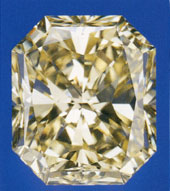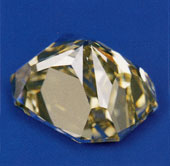PRINCESS AND RADIANT
The princess cut is a square or rectangular shape with a brilliant-style cut. The number of facets varies, but in a princess cut with 57 facets, there are 21 facets on the crown, 32 on the pavilion, and 4 on the girdle. By contrast, the round brilliant cut has 33 facets on the crown and 24 on the pavilion. There are even some princess cuts that are polished with a total of 144 facets.
On the other hand, the cushion-shaped or rectangular radiant cut, which was developed in 1977 before the arrival of the princess cut, has a total of 70 facets. It is difficult to distinguish from the princess cut at a glance, but the two have different facet arrangements, as shown here. Both the princess cut and radiant cut have become standard styles for faceting colored stone such as rhodolite. There are polished with adjustments made to account for different optimum depths, depending on differences in the material's refractive index and depth of color. |
|
Weight:2.10ct
Size(mm):L7.4 xW6.6 x D5.19
Untreated
US$20,000 |
|
 |
Weight:2.70
ct
Size(mm):L8.8 xW7.4 xD5.18
Untreated
US$15,000 |
|
| |
 |
| |
 |
|
 |
JUDGING QUALITY
The appeal of the princess cut lies in the strength of its brilliance, which fills the whole surface of its square or rectangular shape with a beauty from within. That brilliance is not affected by the degree of yellowish color present-as with any other cutting style, it is wholly dependent on the quality of the rough crystal.
Since princess-cut diamonds are cut from octahedral crystals, relatively few will be inferior quality, and very little material of beauty grades C or D is produced. Therefore, grades C and D are not included in the princess-cut diamond quality scale. Most lower-quality rough will end up as commercial-quality round brilliants.
Although the optimal total depth percentage in round brilliant cuts is about 60 percent, the strongest brilliance for princess cuts is seen in depths between 70 and 80 percent. At 60 percent, a princess cut will lose its beauty due to weak brilliance. With diamonds, it makes sense to consider the appearance of the stone in combination with the total depth as a numerical indication of the stone's beauty. Total depth percentage can be easily calculated by dividing the depth of the stone by its width or shortest face-up measurement. |
| |
HOW TO CHOOSE
If several princess cuts are lined up and used together in a piece of jewelry, it is important that they match in brilliance. It is not important that they all be E color, or that they all be VS1 (stones containing minor inclusions that are difficult to see at 10-power magnification). Under the condition that they have matching brilliance, it is important to establish a lower limit of acceptable grades, and to make sure that each stone meets that minimum grade.
Light yellow princess cuts have their own unique beauty. They are also reasonably priced, so they can be considered as long as they match the design of the intended jewelry.
--NEXT PAGE-- |
|